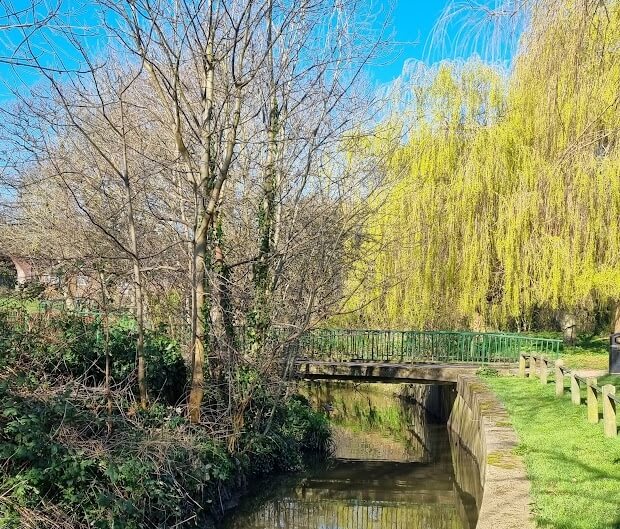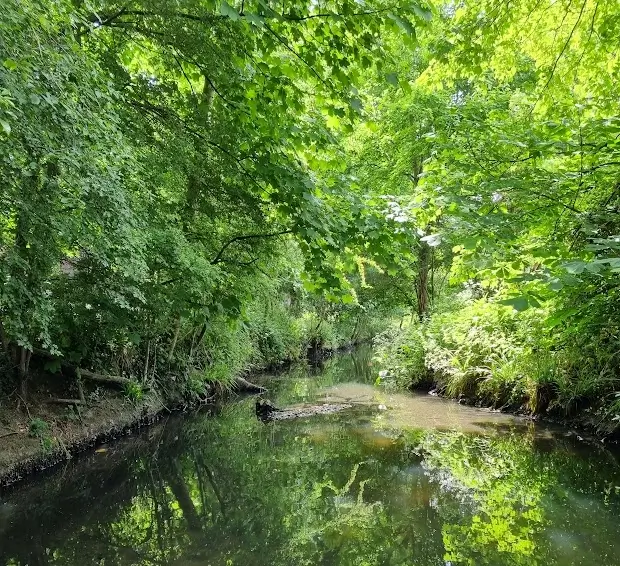The Pymmes BrookERS, a volunteer-run river action group, respond to concerns voiced about a project under consideration that would change the course and appearance of the Pymmes Brook as it flows through Arnos Park.
 The stretch of the Pymmes Brook that runs through Arnos Park has for many decades been contained in a deep concrete channel that has diverted it from its natural course
The stretch of the Pymmes Brook that runs through Arnos Park has for many decades been contained in a deep concrete channel that has diverted it from its natural course
As reported here, in July Enfield Council's Watercourses team ran an engagement event in Arnos Park about a potential project to "re-establish natural geomorphological features" of the Pymmes Brook as it flows through the park. The proposals met with mixed reactions from local people taking part.
In this article, which was originally published by the Pymmes BrookERS on their website, the group seek to make the case for and tackle some of the fears expressed about the scheme, basing their arguments on evidence-based science.
Enfield Council’s Watercourses team has put forward a proposal for a scheme to restore the Pymmes Brook in Arnos Park. There was recently an engagement event in the park to tell people about the scheme and hear their views.
It’s great to see that so many people are passionate about Arnos Park, but it’s becoming clear that there is a lot of misinformation circulating about the proposed scheme to restore the river through the park, some of which is based on fears, not facts. The Pymmes BrookERS offer the points below to tackle some of these fears, we hope they are helpful. All facts on river health are based on evidence-based science – see references at end.
- The proposal comes from the Enfield Watercourses team and is still at an initial stage. The Watercourses team is considering the concerns and views of the community.
- The Pymmes Brook in Arnos Park, and along much of its course, is in very poor health. There are many reasons for this, including pollution and past engineering styles which have re-routed the river into a straight course with a too-deep channel, unsightly concrete sides and base, and many weirs.
- Pollutants in the Pymmes Brook include agricultural pollutants from the farmland in which the river rises, sewage (largely from household and business misconnections, as well as the poor condition of Thames Water infrastructure), and road runoff (oil, petrol and heavy metals that come off vehicles via brake pads and tyres, and which wash into rivers after rain, killing all aquatic life). The level of sewage and road-runoff pollution varies with weather conditions and other factors.
- The weirs in the park (large ‘steps’ or stepped features that the water flows down) were probably installed for ornamental reasons, but they damage river health. Weirs stop fish spawning as they create a barrier to fish passage, so any fish that manage to survive in the river (occasionally we see sticklebacks in there), can’t survive for long. Weirs also slow the flow of the river behind the weir, which causes a stagnant pool behind them, increasing deposits of toxic sediment.
- All is not lost – yet. Re-meandering a river and restoring it to a natural bed (not straight, not concrete) allows the river to flow more naturally and reconnects it to the river valley in which it originally flowed. Fast-moving riffles clean the gravels under which invertebrates live. These invertebrates are crucial to the food web, supplying food for birds and aquatic life. But they can’t survive in dank, concrete-clad, slow-moving water where sediments are constantly being deposited. A natural river is about 30% fast-moving riffles and 70% slower-moving, deeper pools. (Feargal Sharkey told us that when he walked the Pymmes Brook with us back in 2018).
- Adding wetlands improves the river even more as the plants filter out pollutants completely naturally. Wetlands also hold on to volumes of water in heavy rain which helps to reduce flooding both locally (eg the park, path and bordering gardens), and, vitally, downstream in Edmonton where every year housing is flooded after heavy rain. As is often the case with rivers, low-income neighbourhoods are vulnerable to the worst flooding. The wetlands proposed would be incorporated into the re-meandered river and smaller than, for example, the wetlands in Broomfield Park.
- As climate changes and rainfall gets heavier, schemes like this will become more common. Water always wins. If we work with it, we will all win, and there’s an opportunity to create a nature-rich landscape for us all to enjoy. Equally, London and the south-east of England are becoming increasingly dry. We need to look after our rivers better to ensure that they and the species that depend on them survive hotter weather and don’t dry up. In hotter weather, rivers have the critical role of cooling the landscape, people, and wildlife. This is vital in cities like London.
- Re-meandering the river will improve river health and water quality. It will restore biodiversity through riverside planting and wetlands, allowing wildlife to thrive (more dragonflies, kingfishers, herons and fish!).
 Another section of the Pymmes Brook with a more natural appearance
Another section of the Pymmes Brook with a more natural appearance
Fears that have been expressed include:
- “Trees will ‘take over’ the bed of the re-meandered river”. This needn’t be the case if the scheme is well designed. Rivers need some trees to provide shade and keep them cool so that aquatic species can survive. However, there needs to be a balance. If there are too many trees, rivers become too dark/shady for life to thrive. Trees need rivers to provide them with vital water, and they also soak up water, which reduces flooding.
- “Trees and wetland planting will ‘take over’!” We’ve become so used to a nature-deprived environment that we’ve forgotten what nature is like. Research shows that the UK is one of the world’s most nature-depleted countrie: we need more nature everywhere! Species are dying out, damaging our ecosystem. Trees and wetland planting needn’t take over if there is some care and oversight (see next point).
- “The scheme won’t be maintained”. Naturalised rivers don’t need a lot of maintenance. However, the Watercourses team has heard and understood these concerns and is likely to take them on board/come back with some suggestions.
- “The restoration will attract more litter to the river and the park”. As the park is already well-used, we’re not sure how this could happen.
- “Sewage will be less diluted in the restored river.” It is proposed that a sluice at the top of the park will control how much water flows into the new, naturalised riverbed. It can’t and won’t affect the amount of dissolved pollutants or the sediments that is carried in the water, so it won’t increase the concentration of pollutants in the river and will help to remove them. The ‘old’ riverbed will be planted up with riparian (riverside) plants, softening the old river course and improving biodiversity, as well as allowing somewhere for water to go after heavy rainfall.
- “It will be more urbanised.”.It’s hard to know how to counter this as the proposal is about making the park more nature-rich. If the community doesn’t want features like areas for seating/ pond-dipping/picnics for families, tell the Watercourses team what you do want!
- “It will take up all the grassland/meadow.” There are three big fields in the park, which are used occasionally, but are very often empty. The most used part of the park is the path. The park is big enough to include a river restoration and to keep ample grassland for ball games/picnics/sports days and other activities, as well as the existing wildflower areas, woodland, community garden, and playgrounds for children and dogs. The river could be meandered to leave ample meadow space. The new scheme could also include more paths, to allow walkers and dog walkers even more space.
- “Dogs will splash in the river and become ill because of the pollution.” Again, there won’t be a greater amount of pollution than in the existing river. People allow their dogs to splash and cool down at the moment. Dog owners can continue to decide whether to allow their dogs to do this.
- “Toddlers will drown.” The current riverbed has steep, concrete sides and in places a concrete base. It is much more dangerous to children than the proposed new river bed, which will be shallower with more natural sides. Toddlers should always be supervised around water.
- “It’s a waste of council money.” The scheme will not be funded by the council, funding will be obtained from other sources.
- “Council doesn’t clean up motorbikes, trolleys and other rubbish in the river, this is evidence that they won’t maintain the river.” In UK law, councils, landowners, the Environment Agency and others have NO statutory responsibility to clean rubbish out of rivers, which is why this work is so often done by volunteers like the Pymmes Brookers. Until the law changes, the only way to fix this is to roll up your sleeves, get trained up, get your wellies on and come and join the Pymmes Brookers who are actually doing something about it!
- “Our park has always been like this!” Arnos Park has been many things over the years. It was a private estate at one time, with grounds landscaped in the eighteenth-century style. The viaduct was built in the 1930s, serving Arnos Grove tube station, which is a 1930s Art Deco architectural gem. It became a public park in the 1920s and has been a 1950s-style park (flat mown fields, flower beds) for a long time. The river was likely straightened between the 1930s when the viaduct was built and the 1970s. Previous generations of engineers thought that shunting water downstream quickly was best, but nowadays we know that it’s much better to slow the flow and allow more space for water. So, the way the park and the river look are both the product of past eras of thinking. Records from 1200 show that in Old English, the name of the river is Medeseye which roughly translates as ‘Meadow stream’. This tells us what the river used to look like in an even earlier era.
- The Pymmes BrookERS truly believe that any scheme delivered by the Enfield Watercourses team will be high-quality. This team has won awards for its work on the Salmons Brook/Enfield Chase restoration, Wilbury Way wetlands, and Firs Farm wetlands. Go and visit these places and see what we could have on our doorstep! Why shouldn’t we benefit from a major investment into the health and beauty of our local park and river?
- Rivers belong to all of us and can deliver so much enjoyment for us all if we look after them. Let’s use this as an opportunity to bring people together to understand, enjoy and take care of the river and park.
- Use our contact form to get in touch with us and hear more about this proposal as it develops!
References
Road runoff: thames21.org.uk/improving-rivers/road-run-off
River health in UK: theriverstrust.org/rivers-report-2024 See the sections on ‘Remarkable rivers’ for what rivers do for us all; ‘Threats and pressures’ for what challenges they face, including blockages to fish passage like weirs; and ‘Big solutions’ to find out about restoring rivers and nature.
Links
Discussion on the Palmers Green Community forums (July 2024)
Information about the Pymmes Brook restoration project on the GiGL website (Greenspace Information for Greater London)
"Our hopes for a biodiversity boost in Arnos Park" (Article by Pymmes BrookERS in the September 2024 issue of Enfield Dispatch)




